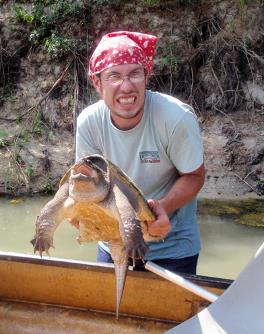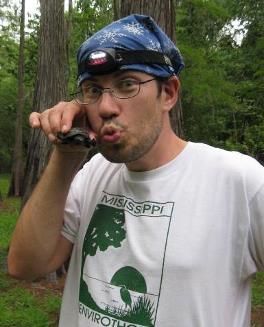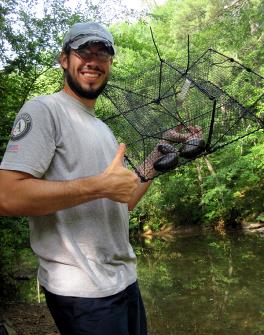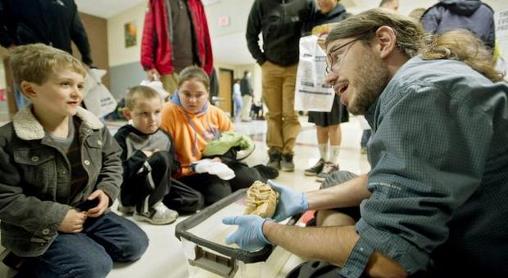|
Chris Thawley
PhD Student Email: [email protected] Office: 508 Mueller Laboratory Phone: 814.867.2252 Curriculum Vitae Philosophy of Teaching Statement Education BS 2004 Davidson College MS 2011 University of Alabama Research Interests Most environments across the Earth are experiencing accelerated rates of change due to human-driven causes. Habitat destruction or alteration, climate change, and the introduction of invasive species represent new challenges for diverse organisms as they struggle to survive and reproduce. While these changes can be very rapid, organisms can also respond quickly to these new conditions via different routes of adaptation; phenotypic plasticity, genetic changes, and epigenetic alterations all have a role to play in allowing organisms to achieve higher fitness in novel environments. I use integrative studies to investigate the processes and consequences of rapid adaptation by focusing on the interactions between eastern fence lizards (Sceloporus undulatus) and an invasive predator, red imported fire ants (Solenopsis invicta). Previous research has shown that these lizards have adapted behaviorally and morphologically to these ants within <70 years. Questions I am investigating as part of my thesis work include: · Do lizards with these adaptations survive and grow better than lizards without them in the presence and absence of fire ants? · Do the effects of fire ants on fence lizards vary across ontogeny? · Are these novel adaptations optimal or do they carry fitness costs? · Do epigenetic changes underlie behavioral adaptations seen in these lizard populations? · Does the presence of fire ants reverse existing latitudinal gradients in morphology, behavior, and stress responses of fence lizards across their range? Scientific outreach and education are also a major focus of my work. I work with fellow Biology Graduate Students to design, build, and present original outreach opportunities at local schools and national science festivals. I’m also working to develop and co-teach a new class at Penn State for both grads and undergrads focused on how to effectively build outreach opportunities and communicate science to a variety of audiences. For more details, pretty pictures, or different points of view on my research, check out some of my posts on our lab blog, the Lizard Log! Or check out an example of a recent guest lecture I gave on invasion biology! |
Publications
Thawley, C.J. and T. Langkilde. 2015. Invasive fire ant (Solenopsis invicta) predation of eastern fence lizard (Sceloporus undulatus) eggs. Journal of Herpetology. Accepted. Thawley, C.J. and F. Graves. 2015. Geographic distribution: Gyrinophilus porphyriticus. Herpetological Review. 46(2):210. Newman, J.C., C.J. Thawley, T. Langkilde. 2014. Red imported fire ant predation on eggs of the eastern fence lizard. Herpetology Notes 7:415-418. Thawley, C.J. and F. Graves. 2014. Geographic distribution: Plestiodon fasciatus. Herpetological Review. 45(4):661. Thawley, C.J. and F. Graves. 2014. Geographic distribution: Plestiodon laticeps. Herpetological Review. 45(4):661. Thawley, C.J. and M.W. Herr. 2014. Geographic distribution: Plestiodon laticeps. Herpetological Review. 45(4):661. Thawley, C.J. and F. Graves. 2014. Geographic distribution: Sceloporus undulatus. Herpetological Review. 45(4):662. Thawley, C.J. and F. Graves. 2014. Geographic distribution: Pantherophis guttatus. Herpetological Review. 45(4):665. Thawley, C.J. and F. Graves. 2014. Geographic distribution: Alligator mississippiensis. Herpetological Review. 45(2):279. Thawley, C.J. and F. Graves. 2014. Geographic distribution: Trachemys scripta scripta. Herpetological Review. 45(2):281. Thawley, C.J. and F. Graves. 2014. Geographic distribution: Anolis carolinensis. Herpetological Review. 45(2):282. Thawley, C.J. and F. Graves. 2014. Geographic distribution: Sceloporus undulatus. Herpetological Review. 45(2):283. Thawley, C.J. 2014. Egg predation: Coluber constrictor. Herpetological Review. 45(1):142. Thawley, C.J. 2013. Geographic distribution: Chrysemys picta. Herpetological Review. 44(4):622-623. Thawley, C.J. 2013. Geographic distribution: Plestiodon fasciatus. Herpetological Review. 44(4):626. Thawley, C.J. and B.E. Carlson. 2013. Geographic distribution: Hyla versicolor. Herpetological Review. 44(4):621. Thawley, C.J., G.L. McCormick and S.P. Graham. 2013. Geographic distribution: Heterodon platirhinos. Herpetological Review. 44(3):476. Thawley, C.J., G.L. McCormick and S.P. Graham. 2013. Geographic distribution: Opheodrys aestivus. Herpetological Review. 44(3):477. Thawley, C.J. 2012. Geographic distribution: Eleutherodactylus planirostris. Herpetological Review. 43(2):298. Newman, J.C., G.C. Brooks, and C.J. Thawley. 2012. Geographic distribution: Deirochelys reticularia. Herpetological Review. 43(4):615. Thawley, C.J. and S.P. Graham. 2012. Geographic distribution: Eurycea chamberlaini. Herpetological Review. 43(2):296. Thawley, C.J. 2011. Geographic distribution: Anolis (Norops) sagrei. Herpetological Review. 42(2):239-240. Thawley, C.J. 2010. Geographic distribution: Hemidactylus turcicus. Herpetological Review. 41(3):378. Stevenson, D.J., J.G. Palis, A.D. Walde, A.B. Safer and C.J. Thawley. 2009. New distributional records forGeorgia amphibians and reptiles. Herpetological Review. 40(2): 247-249. |




